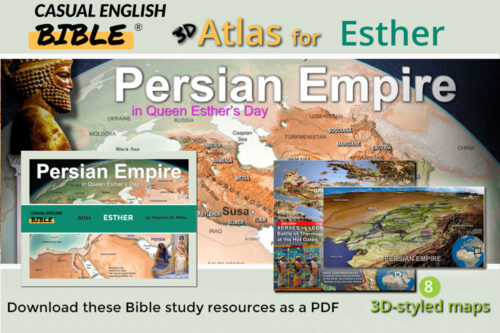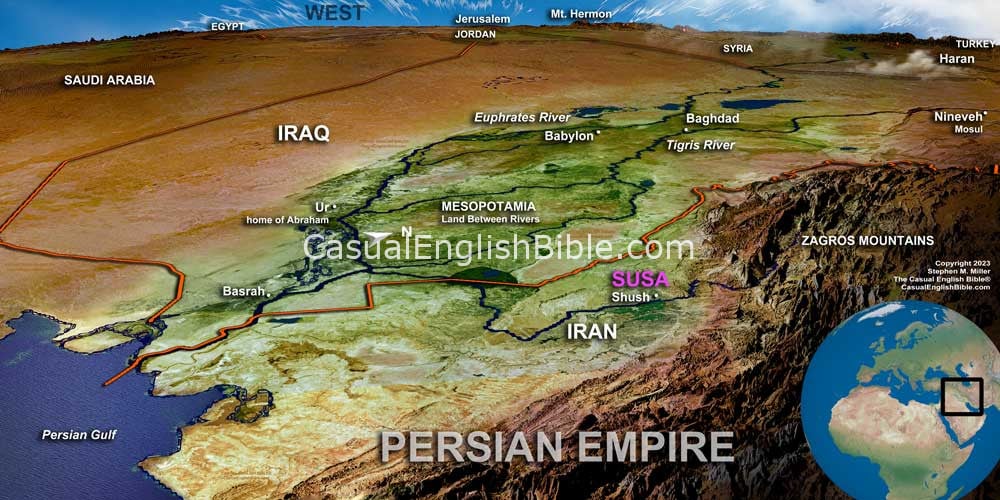Esther 9
Jews start the custom of Purim
Open season on Jews, Persians
1March 7 was the day the king’s two opposing decrees took effect.- His first decree: Persians could kill Jews. [1]
- His second decree: Jews could fight back and kill Persians.
2In cities throughout Xerxes’ provinces, Jews assembled into defensive militias to kill enemies planning to hurt them. No one could defeat the Jews because everyone had grown afraid of them. [2] 3All the governors and regional leaders backed the Jews because they were afraid of Mordecai. 4Mordecai was a powerful leader, and he was getting more powerful all the time. People recognized that.
Body count of dead Persians
5Jews decimated their enemies. They slaughtered them and did whatever they wanted with everyone who had hated them. 6In the Persian capital city of Susa alone, Jews killed 500 people.7Among the dead, all 10 sons of Haman: Parshandatha, Dalphon, Aspatha, 8Poratha, Adalia, Aridatha, 9Parmashta, Arisai, Aridai, and Vaizatha. 10These were the 10 sons of Haman, who was the son of Hammedatha the Jew-hater. Jews didn’t take anything from these dead people.
11Susa officials reported the death toll to the king that same day.
Bonus day on the battlefield
12The king told Queen Esther, “In Susa alone, the Jews killed 500 people, along with all 10 of Haman’s sons. We can only guess how many people Jews killed throughout all the provinces. What would you like me to do for you next? Ask and I’ll do it. You make the wish. I’ll make it happen.”13Esther said, “If it’s okay with you, give the Jews another day to mop up. And hang the bodies of Haman’s 10 sons on poles.” 14So, the king gave the order. His people hung the bodies of Haman’s 10 sons on poles as a public display.
15Jewish fighters reassembled a day later, on March 8. They killed 300 more enemies in Susa. Again, they took nothing from the dead. 16Jews throughout the king’s provinces killed a total of 75,000 enemies but took nothing from them. 17This happened on March 7. The next day they rested and celebrated by eating together. 18It was different in Susa. There, they fought on March 7 and 8. They rested and celebrated on March 9.
Purim, the Happy Day Holiday
19From that day on, Jews living in villages outside walled cities [3] have celebrated this victory on March 8, [4] a day before the others. It’s a happy day for gifts, parties, and food.20Mordecai wrote all about what happened. And he sent the report to officials in all the king’s provinces. 21He advised the leaders in all the provinces to reserve both days, March 8 and 9, as annual holidays.
22He told them to celebrate with joy, and to give gifts of food to each other, along with gifts to the poor. He said this holiday would serve as a reminder to Jewish people throughout the generations. It would remind them that they defeated their enemies, and they turned fear into joy and tears into laughter. 23So, the Jews started what became the tradition of celebrating, just as Mordecai said.
Why the holiday is called Purim
24Haman, son of Hammedatha the Agagite, an enemy of the Jews, tried to destroy the Jews. He rolled the dice [5] to pick a day for the slaughter. 25But Esther took a stand before the king. And the king supported her. He issued a decree that made Haman’s plan backfire. Haman wanted to kill Jews. But he ended up hanging on a pole, and so did his sons.26The dice, called pur, is why the holiday became known as Purim. It exists because of what Mordecai wrote and because of what the Jews experienced.
27Jews chose to celebrate the day and make a custom of it because of everything that happened to them. They decided to continue observing these two fun-filled holidays every year. 28They agreed to honor this Purim tradition year after year—forever—in every family of every province and city.
29Queen Esther wanted to add her support to what Mordecai wrote about Purim. So, she wrote a letter backing what he said. 30Messengers delivered the letters. Mordecai and Esther addressed them to Jews in all 127 Persian provinces. The letters said they hoped the Jews were safe and could now live in peace.
31Queen Esther and Mordecai each wrote that the Jews should observe the happy Purim holiday every year, just like they do the more solemn festivals and scheduled days of fasting. 32Esther’s command establishing the Purim holiday was written into the palace records.
Footnotes
Esther 3:12.
As they should, since the king now favored the Jews, was married to a Jewish Queen, and had appointed Mordecai a Jew as the empire’s top official.
It’s unclear which Jews were celebrating Purim on what days. One ancient Jewish tradition says Jews living in cities that had been walled since the time of Joshua celebrated Purim on Adar 15 on the Hebrew calendar, two days after Haman’s scheduled slaughter of the Jews on Adar 13. Jewish tradition said Jews everywhere else celebrated on Adar 14, one day after the scheduled holocaust. Rural Jews first, and city Jews a day later. In Jerusalem, a city walled in Joshua’s time, Jews celebrate on Adar 15.
It’s a bit more complicated than “March 8.” The date floats to other days on the calendar. That’s because Jews in Bible times followed a lunar calendar, with every month starting at the first tiny crescent after the new moon. A new moon is when the moon is hidden behind earth’s shadow for one day. The sun, moon, and earth are aligned, with earth in the middle. “March 8” here is “Adar 14” on the ancient Jewish calendar. That date can fall on various days in March on the modern calendar.
More literally, they were to throw or draw “lots.” The “lots” may have been stones or animal bones marked in a way that produced random outcomes for “yes” or “no” answers. The idea is like throwing dice or like flipping a coin for “heads” or “tails.” “Lots” in the Akkadian language of the region was pur. That’s where the name of the festival Purim comes from.
Discussion Questions
- Sorry, there are currently no questions for this chapter.







